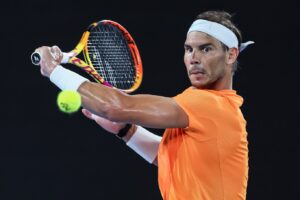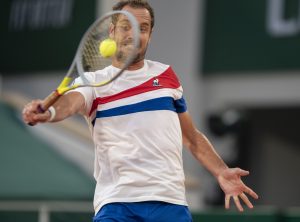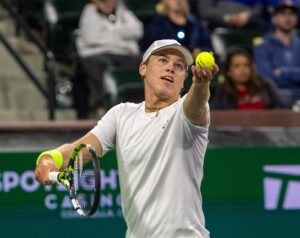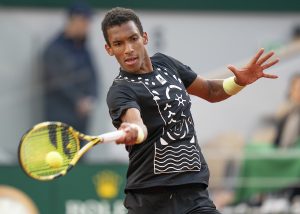In tennis, counterpunchers are the players whose games are built up around reacting to their opponent’s shots. There are two types of counter punchers–aggressive and defensive. They are essentially the same styles of play, that strives off of a high percentage tactic. But, on a closer look, there’s a subtle difference between the two styles. A defensive one simply retrieves the ball back as long as the opponent doesn’t finish the point. The subtle difference lies in the fact that an aggressive one will do almost the same, but with some interest and possesses the ability to finish off the point by themselves. And convincingly so. A big similarity in most defensive counterpunchers’ game is that their tactics revolve around a high percentage tennis–playing a safe game without any risk whatsoever, that is–unlike an aggressive counterpuncher.
To put that in perspective, imagine Roger Federer’s match against John Millman at the US Open. We all remember how the Australian was simply getting everything back in play waiting on a Federer error. And, let’s take into account Federer’s recent match against Roberto Bautista Agut in Shanghai. The Spaniard put everything back in play, but with interest and troubled Federer for the longest part of the match until the very last moment.
Now, why the annoyingly long preface explaining what a counterpunching style of play is? It’s to explain and delve a little to point out the subtle change that Croat rising star Borna Coric has gone through to make the necessary strides forward.
When he came on to the scene, he was the teen darling of tennis, beating Rafael Nadal at 17 and Andy Murray at 18 years of age, respectively, within a span of six tournaments. He entered the Top 35 at just 18, but ever since, the tremendous hype that was created around him had died down. And while the Alexander Zverevs, the Hyeon Chungs, or the Stefanos Tsitsipas captured all the front row seats, it’s almost as if Coric took the role of a sidekick.
Tennis players need obvious weapons in their games to make it big on the circuit. Having a definite weapon often serve as the difference between a good player and a great one. For example, Roger Federer has his serve and forehand, Nadal has his forehand and topspin, Novak Djokovic has his backhand and athleticism, and they all have achieved a boatload of accolades due to their weapons. Borna Coric, well, he never quite had those; but what he did have was an inherent capability to work hard that can separate him from his peers.
Since dropping in the rankings, his improvement has been steady. He figured out what he needed to do. And that’s where the aforementioned subtle improvement comes into play. When a player is inside top-50, they don’t require to make drastic changes to their games to take a step in the right direction. It can be a slight change in forehand technique, or a slight change in posture while serving and whole new possibilities arise for the aspiring player.
Coric’s coach Ricardo Piatti–boasting of a coaching resume of taking Ivan Ljubicic from 900+ to 3rd, Milos Raonic from 11th to 3rd, and even coaching a young Novak Djokovic (parting ways only because he refused to work full-time with Djokovic)–had understood his problems. His subtle change in his forehand technique and most importantly, his change in style of play from a defensive to an offensive counterpuncher has paid dividends already.
Coric’s Shanghai Masters quarterfinal match-up against the Aussie Matthew Ebden showed exactly why he had drifted away from the spotlight for a while and now that he looks to be back, he should stay for a long while. His serve has considerably improved, almost to the point where he can expect to win a few free points on serve, something that wasn’t quite the case before. But, most importantly, against an offensive player like Ebden, he didn’t sit back and wait for the error. He took the initiative, went down the line whenever opportunity knocked instead of hitting another safe bet cross-court ball back in play. He attacked with confidence even after getting broken in the first game itself.
Also to note at this point that Borna Coric has physically improved, too. His shots are no weapon, yet, but they can very well be in the near future if he keeps getting stronger physically and technically the way he is right now.
Coric’s semifinal against Roger Federer will be his third match-up against the Swiss legend in 2018. Each one of the matches proved crucial in tracing his improvement over a period of time. During their Indian Wells semifinal, Coric called the shots, he attacked with courage and almost took the match from a struggling Federer. Coric was ranked 49th at the time. As it often happens to lower ranked players, he couldn’t maintain the same spirit throughout and failed to finish the job, losing 75 46 46.
During Halle final, Coric was Top 35 and matured up a bit more, finishing the job this time. He kept the plan simple–put the ball back in play with interest, wait for Federer to err and put away balls at any chance he gets. In the end, a surprising 76 36 62 win was his reward.
Now that they are facing off at Shanghai semifinals, it’s another step forward for Borna Coric. He’s guaranteed a Top 15 place next week with the run to the semifinal, being one of the most improved players this year. And thus, a lot more mature with a better understanding of how to execute the perfect game plan to dismantle Roger Federer. But, regardless of what happens on Saturday, Borna Coric has proven his point. He’s not going to go away anymore. It will be foolish to write him off at the big tournaments from now on..
Main Photo:
Embed from Getty Images






